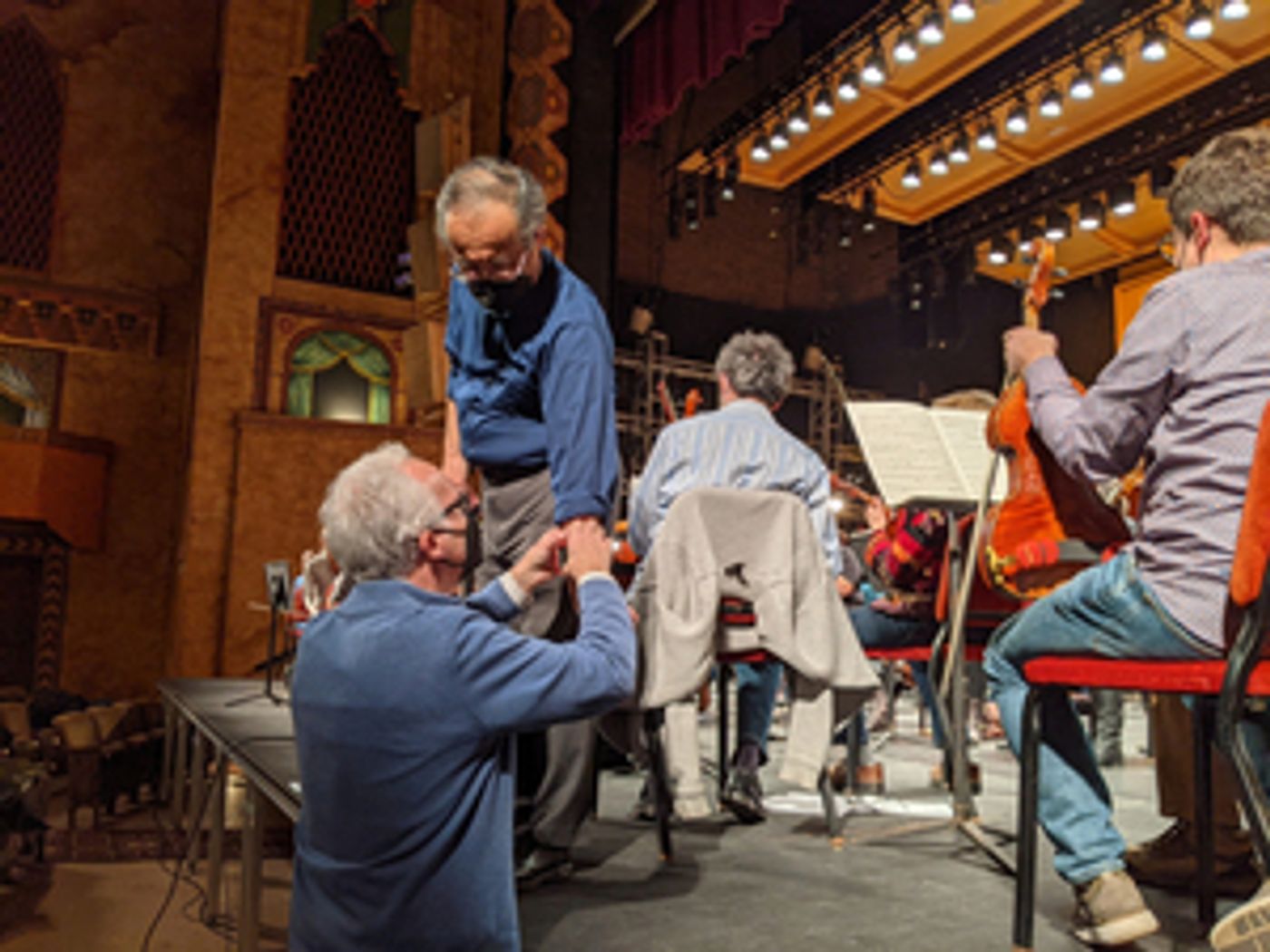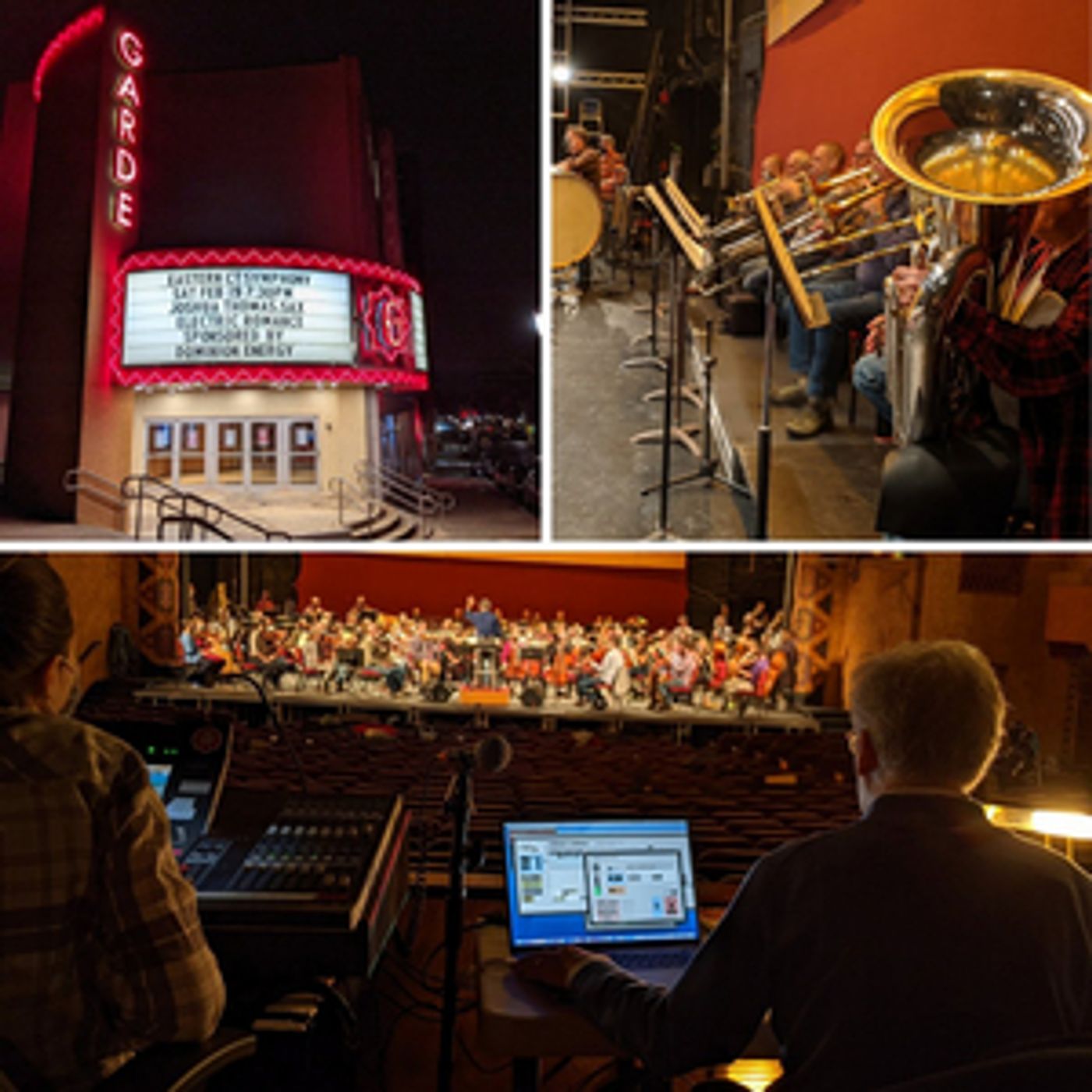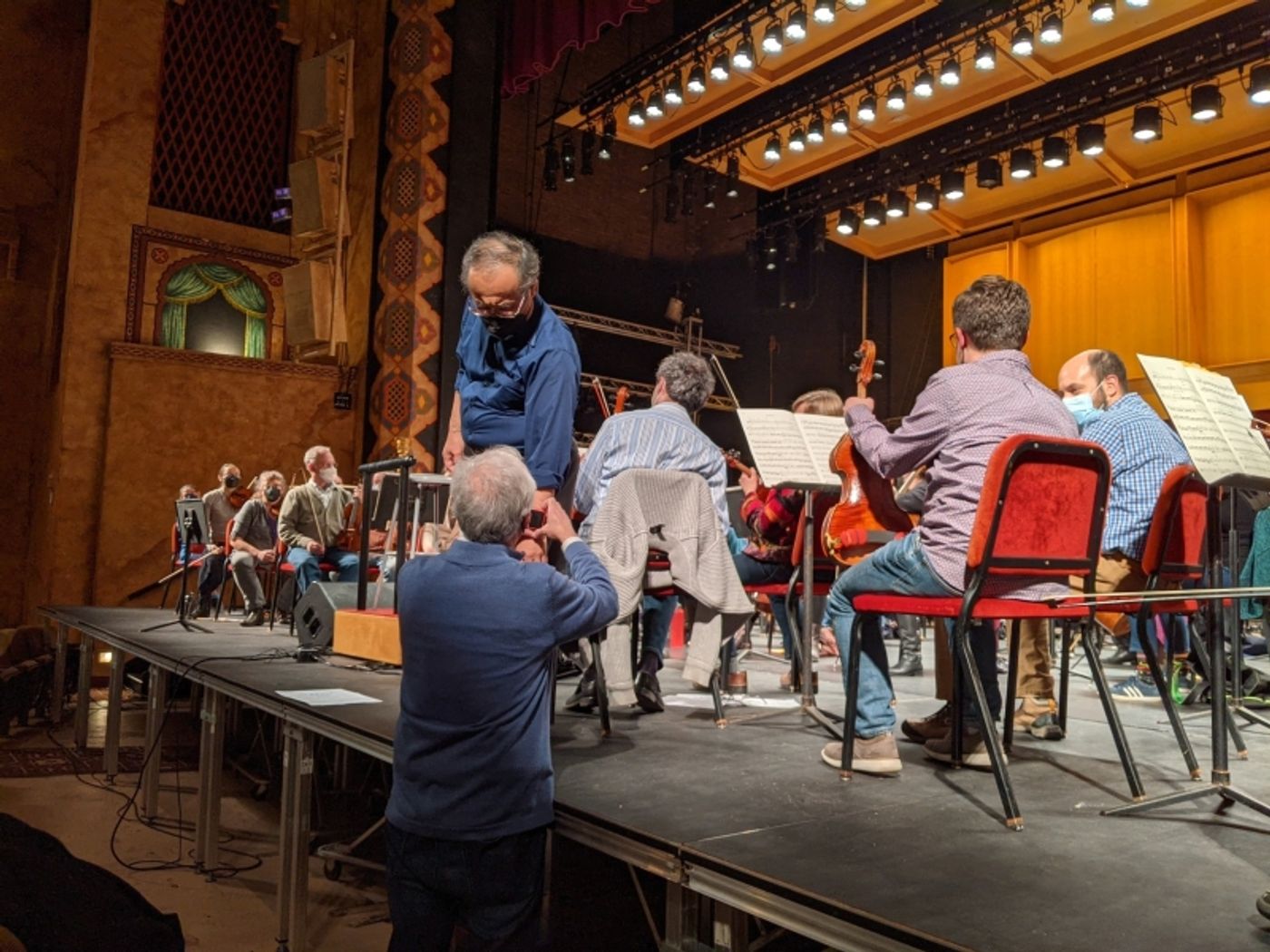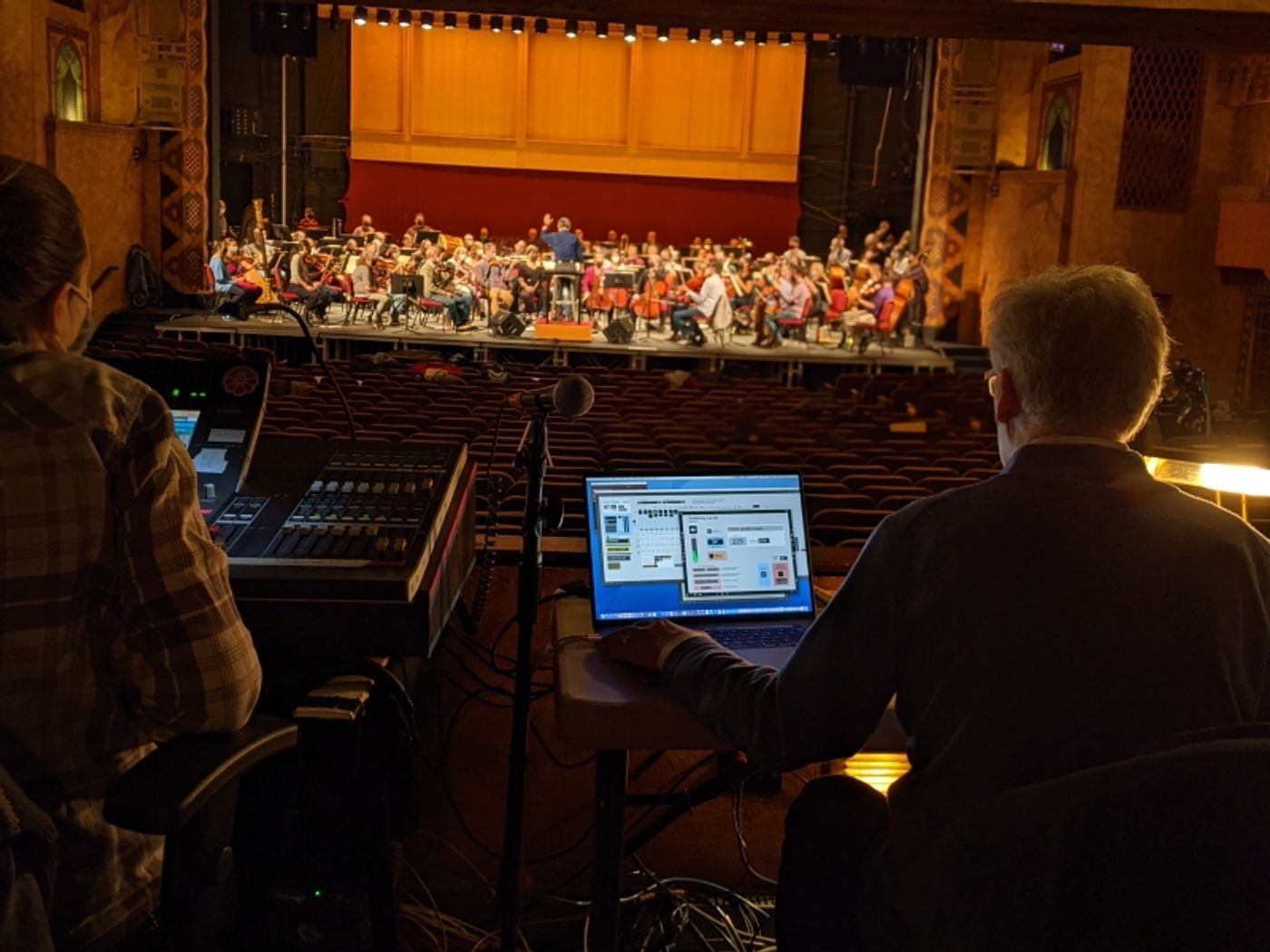Interview: Toshiyuki Shimada, Joseph Butch Rovan of SCATTERING at Garde Arts Center
The world premiere of ground-breaking electroacoustic piece that includes a brand new instrument, technology, and explores two major world events.


On February 19, 2022, I had the opportunity to perform with Eastern Connecticut Symphony Orchestra (ECSO) in the world premiere of Scattering, a ground-breaking electroacoustic piece that explores two of today's most prominent world events: the Covid-19 pandemic and the death of George Floyd, all the while including a brand new instrument especially designed for the orchestra conductor to wear on his wrist, performing alongside the musicians.
In the months prior to the performance, the ECSO recorded small excerpts which the composer, Joseph Butch Rovan, then analyzed and reimagined, changing the sound entirely and making it coordinate with a special wrist-worn device during the live performance. The device, called TOSHI (The Orchestra Synthesis Human Interface) was expertly worn by its namesake, Toshi Shimada, the ECSO conductor. The piece continues to break barriers with not only the invention of a new instrument, but by making it one that the conductor wears to make him a performer alongside the symphony musicians. Furthermore, the device communicates with the composer's laptop at the back of the audience, sending out a variety of sounds (including the sound of a person exhaling) through the surround system at the theater.
After learning about this novel work, I wanted to learn more, so I sat down with the conductor and composer just before the premiere.

Ariana: Mr. Rovan, what is the piece about?
Butch: That's a big question. About so many things. On one level, it's about just pure music and the power that music has to convey feelings and emotions and everything else that things that we can't say with words. So, it's this really powerful way of communicating. At the lower level, the piece itself is about the world we're living in right now. It's hugely influenced by the Covid-19 pandemic and the murder of George Floyd. Those two things intersected in a powerful way. We have been talking about doing this piece for quite a number of years and I was waiting to get my sabbatical (Rovan teaches at Brown University). My team and I started building programming for the TOSHI device and, in the spring of 2020, I was ready to hunker down to start writing the orchestral score, but then the pandemic happened. Shortly after that, the murder George Floyd, and so like everything changed about our world just like in a matter of months. I mean not that social injustice had suddenly appeared, but our awareness of it was very acute and sudden.
So, those ideas just really influenced the score in a way. I had already had the idea of Scattering, and that was the initial idea that was from his poem by William Meredith. I really loved the sort of formal structure and the images that are embodied in that poem, Scattering. So there was that kind of impulse. I've often been inspired by poetry and text at different ways, like I said, it's kind of one of my working methods. It was kind of natural to look for poetry. We had the the American poem, but then everything changed, so Scattering became this bigger thing about, "How are we connected?" In this world where we're suddenly not connected. Meredith's poem was all about the ways that we were connected, but suddenly we were the opposite of that. So, that's what the piece is about on a philosophical level.
Ariana: Nice. Is there anything that you want the audience to know about what you personally wanted to express in this piece?
Butch: I would like them to feel their own lives and, you know, reflect on their own experiences through this whole thing. 'Cause we all have our own stories related to what's happened and it's kind of a moment of reflection. The music allows us to do that where you know to to enter into it, and then we kind of create our own stories. It's a way to, I hope, pull us together and bring our stories together.
Ariana:
So I know I know that you do usually incorporate technology into your work, but is this the first time that you've ever made a device for your work?
Butch:
No, I actually do that a lot, but this is the first time that I built technology for someone else to perform with. Usually, I build technology and I perform with it. I do a lot of performance with various kinds of instruments that I design. I teach instrument design and building at my classes at Brown [University]. But this was really, really a first because I designed this thing for Toshi [Shimada]. I feel very close to Toshi in lots of ways and I've really admired as conducting style and talent for a long time, so, it was really cool to figure out what I [could] build for him that would allow him to sort of express his electronic score.
Ariana:
What are some of the unique challenges of creating this work? I know you had recorded the Eastern CT Symphony Orchestra musicians some months prior [for the piece]. What role did that recorded symphony play? Does it have a title [in the score]?
Butch:
In this kind of work that I do, it's very, not just me, but it's very common for like electronic music composers - the term that's used a lot as electroacoustic. So, you'll see electroacoustic and that kind of means that you combine electronics with acoustic [music]. It's very common to do recordings of things. I've done lots of pieces that are recordings of objects, you know, like 'cause that kind of music is a lot about trying to find interesting timbres. I mean, in the room we're in right now, we could probably do 100 interesting recordings of various objects that you could use to create a piece out of, and that process usually involves doing things like spectral analysis of the sound and finding interesting things in the spectrum, and then modeling or processing that and creating synthetic versions of that, so the recordings became this kind of a launching point for creating sounds.
In the recording that the orchestra did last November, it was sometimes just like a chord, passage, or just a couple bars (like 2 beats). I had given Toshi a list of these little bits, so I was looking for particular spots where I thought they would be fruitful sources.
Spectral analysis looked inside that timbre and pulled certain things out of them or actually modeled them, using that timbre material and the mathematical aspects of the spectrum as a way to model a hybrid version of that spectrum. So, the recordings aren't an instrument. The sound from those recordings are like the paint for a painter, like the piece is a canvas. The recordings are raw materials and I'm looking into them and pulling bits and pieces out kind of making new colors out of the bits and pieces. So, the sounds you hear are various parts of different spectra from the different sounds and they are very few actual bits that recording that you're hearing - just a few bits that are recognizable.
Ariana:
Wow! OK, very interesting. You do work with a mixing board at the back of the theater that is registered to The TOSHI [device] and Toshi [Shimada]. What is different about each of the performances? Is there an improvisational element?
Butch:
Yeah, well I mean that would be a question for Toshi. I mean he has a part with some suggestions, but he's he's creating it through his gestures and so that's his improvisation.
Ariana:
That leads to one of my next questions, but it'll come up in a minute. We can hear someone breathing on this piece, so whose breath is that? And then who does that breath symbolize?
Butch:
I'll leave it a mystery who's the breath is, I'd like just to leave that as a bit of history. But what does this symbolize? This symbolizes all of us, like you know. I mean, there's the literal aspect of COVID and George Floyd, "I can't breathe." We can't breathe. There's also the collective breath that we have as you know, is this idea that we're hopefully coming together and that we need to come together. Breathing is this fundamental aspect of existence and I hope that's the sense that people get. It's a way that we could acknowledge our common humanity.
Ariana:
And the three exhalations at the end of the piece? Is there something that you'd like your audience to know about those last three [breaths]?
Butch:
Well, I don't know. ... There's sort of the destructive energy of COVID that runs through the piece, in lots of ways, and there's the poignancy of George Floyd that intersect. At the end, I mentioned this, in the video that we did [for Eastern CT Symphony Orchestra], that it's really kind of like a question at the end of the piece. Like that you get to this point and it's it's not end like we have not solved anything, but it's really like a question. And I think that's where you know these three breaths lead us to something else. Not sure what yet, but they lead us to something.
Ariana:
Thank you very much. So, Toshi, I have a bunch of questions for you: What role does the conductor play in this piece?
Toshi:
Simply, well, there are two factors: To lead the orchestra, of course. That's the one area, of course, I'm more comfortable with. Then, producing the sound with the TOSHI machine. That's a difficult challenge in many ways. It's first thing I've done things like that too. And the first thing anyway.
We practiced several times for me to find where [were] the sounds and how to produce the sounds. For that, it was quite difficult initially. I was just experiencing. Because I did not have his computer at my home, I couldn't really practice at home. I ended up videotaping myself, finally. I could [then] watch, which ways would produce the sound. And another part is to produce the sound that somewhat makes sense at the time and the best spot. He [Rovan] has designated what kind of a sound should come out. For me to produce that is my own judgment.

Rovan:
Yeah, like they're like these possible. It's a kind of. Each area has a set of possibilities, but it's up to Toshi to choose them.
Toshi:
It's the Area out of a classical music more into like jazz or improvisation part, but it's not really improvisation because I have to fit into this schematic frame of his thoughts. Every time we stop the section, he has to switch and get quickly to the next section.
Ariana (to Rovan):
So you're a performer as well! You're not just a technician, you're performing.
Rovan:
Yeah, I'm glad you mentioned that! I'm performing and doing all these other things. I can't even write any notes while the piece is going by. It's a challenge for me to just sit back and enjoy the piece because I'm doing all this stuff. I'm as much in it as you [the symphony musicians] are.
Ariana:
So what's written in the score about the types of movement? Do you designate that you're looking for a sound or a specific movement that Toshi then elaborates on, in like the cadenzas?
Butch:
It'll have markings about the gestures. It's more about like, well, these are the kind of gestures that would make sense, like, "Move arm up slowly and down" or "Start down..."
Ariana
Does it always sound the same?
Toshi & Rovan (together) No.
Ariana:
It never sounds the same and is it based on the response? So, obviously Toshi's going to change how he brings his arm up and down, but you're [Rovan] mixing things on the laptop so it will always be different?
Rovan: No, I'm actually not mixing his sound. I'm sort of like changing the possibilities of different moments, but I'm not really affecting it. All the sound that Toshi makes that's totally up to him. But the reason it's always a bit different is just because it's mapping multiple aspects of this movement. It's mapping the vertical, but it's also mapping the tilt this hand. It's also mapping the left and right direction, to some extent, depending as it changes over the course of the piece. But there's so much interaction that happens between all these things that, any way you move, you're going to find another version of the sound because of the way Toshi's just moving.
Toshi
Some sounds, like, kick. Some places just smooth sound. So how do you instigate the sound or produce the sound? It's different, too. He has it noted in there mostly.
Ariana:
What was the collaboration like between you [Rovan & Toshi] and Eastern Connecticut Symphony to make this come to life?
Rovan
It started with a lot of conversations, yeah?
Toshi:
Yeah, it goes way back.
Rovan:
Talking in the lobby after a concert, you know we would meet after, [saying to each other] you know, "We've got to do something!" ... Finally, it was possible in Spring 2019. We scheduled it and rescheduled it.
Ariana:
Well, it's such a special piece in that everyone involved is a performer and it is so unique to this exact theater, this group (Eastern CT Symphony Orchestra), and the people surrounding it. So I think it's really special and very fascinating. Thank you for speaking with me.
Toshi
The orchestras has a lot of responsibility for executing these notes because he has spelled out "COVID".
Ariana:
Yes, the cryptogram, right?
Toshi:
Yes, you're right, like Shostakovich's cryptograms. So, the the orchestra part is very important as well.
Butch:
The name "George" and "Covid-19" is spelled out [in the score]. It's a difficult score, I think, because there's a lot of interlocking parts. I did want to give a shout out to the the whole crew at the Garde Arts Center, like Steve Siegel and Sophie Ball Share. One of the cool things we've been able to do is to use the surround sound system, which they've never used for an audio [concert] production. The sound system has always just been dedicated to the the movie system and Sophie was able to splice together the movie surround system with the regular sound system so we could get a 6-channel surround sound.
Ariana:
This is all fascinating. Thank you guys so much for sitting down with me on, especially on a concert day. I look forward to putting this together.

Videos

